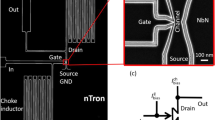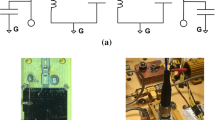Abstract
We present a low-power inductorless wideband differential cryogenic amplifier using a 0.13-µm SiGe BiCMOS process for a superconducting nanowire single-photon detector (SNSPD). With a shunt-shunt feedback and capacitive coupling structure, theoretical analysis and simulations were undertaken, highlighting the relationship of the amplifier gain with the tunable design parameters of the circuit. In this way, the design and optimization flexibility can be increased, and a required gain can be achieved even without an accurate cryogenic device model. To realize a flat terminal impedance over the frequency of interest, an RC shunt compensation structure was employed, improving the amplifier’s closed-loop stability and suppressing the amplifier overshoot. The S-parameters and transient performance were measured at room temperature (300 K) and cryogenic temperature (4.2 K). With good input and output matching, the measurement results showed that the amplifier achieved a 21-dB gain with a 3-dB bandwidth of 1.13 GHz at 300 K. At 4.2 K, the gain of the amplifier can be tuned from 15 to 24 dB, achieving a 3-dB bandwidth spanning from 120 kHz to 1.3 GHz and consuming only 3.1 mW. Excluding the chip pads, the amplifier chip core area was only about 0.073 mm2.
摘要
为有效读出超导纳米线单光子探测器 (SNSPD) 输出信号, 提出一种基于0.13 μm SiGe BiCMOS工艺的低功耗无电感宽带差分超低温放大器. 为解决缺少超低温器件精确模型的问题, 结合并联—并联反馈和电容耦合超低温放大器结构, 通过详细理论分析和仿真, 确定了放大器增益与电路可调设计参数间的关系, 提高了设计和优化的灵活性, 从而实现所需增益. 为实现工作频率范围内端口阻抗平坦特性, 采用RC并联补偿结构, 有效提高了放大器闭环稳定性, 并可抑制放大器过冲问题. 给出室温 (300 K) 和低温 (4.2 K) 下S参数和瞬态性能测试结果. 在良好输入输出阻抗匹配下, 该放大器在300 K温度下3 dB带宽为1.13 GHz, 增益为21 dB. 在4.2 K温度下, 该放大器增益可在15~24 dB范围内调节, 其3 dB带宽为120 kHz~1.3 GHz, 功耗仅3.1 mW. 去除芯片外围焊盘, 该超低温放大器芯片核心面积仅为0.073 mm2.
Similar content being viewed by others
References
Bardin JC, Weinreb S, 2008. Experimental cryogenic modeling and noise of SiGe HBTs. Proc IEEE MTT-S Int
Microwave Symp Digest, p.459–462. https://doi.org/10.1109/MWSYM.2008.4633202
Bardin JC, Weinreb S, 2009. A 0.1–5 GHz cryogenic SiGe MMIC LNA. IEEE Microw Wirel Compon Lett, 19(6): 407–409. https://doi.org/10.1109/LMWC.2009.2020041
Bardin JC, Weinreb S, 2010. A DC-4 GHz 270Ω differential SiGe low-noise amplifier for cryogenic applications. Proc 5th European Microwave Integrated Circuits, p.186–189.
Birnbaum K, Charles JR, Farr WH, et al., 2011. Deep-space optical terminals: ground laser receiver. Proc Int Conf on Space Optical Systems and Applications, p.136–141. https://doi.org/10.1109/ICSOS.2011.5783657
Cahall CT, Gauthier DJ, Kim J, 2016. Cryogenic amplifiers for a superconducting nanowire single photon detector system. Proc Conf on Lasers and Electro-Optics, p.1–2.
Cha E, Wadefalk N, Moschetti G, et al., 2020. InP HEMTs for sub-mW cryogenic low-noise amplifiers. IEEE Electron Dev Lett, 41(7):1005–1008. https://doi.org/10.1109/LED.2020.3000071
Chang SW, Bardin JC, 2017. A wideband cryogenic SiGe LNA MMIC with an average noise temperature of 2.8 K from 0.3–3 GHz. Proc IEEE MTT-S Int Microwave Symp, p.157–159. https://doi.org/10.1109/MWSYM.2017.8058926
Debnath B, Das JC, De D, 2019. Nanoscale cryptographic architecture design using quantum-dot cellular automata. Front Inform Technol Electron Eng, 20(11):1578–1586. https://doi.org/10.1631/FITEE.1800458
He L, Li LM, Niu XK, et al., 2019. A low-power, inductorless wideband cryogenic amplifier for superconducting nanowire single photon detector. IEEE Trans Appl Supercond, 29(6):2200306. https://doi.org/10.1109/TASC.2018.2890700
Kitaygorsky J, Slysz W, Shouten R, et al., 2017. Amplitude distributions of dark counts and photon counts in NbN superconducting single-photon detectors integrated with the HEMT readout. Phys C Supercond Appl, 532:33–39. https://doi.org/10.1016/j.physc.2016.11.008
Korolev AM, Shulga VM, Turutanov OG, 2016. An ultra-low-power multi-octave deep-cooled amplifier for superconducting single-photon detectors. Proc 9th Int Kharkiv Symp on Physics and Engineering of Microwaves, Millimeter and Submillimeter Waves, p.1–3. https://doi.org/10.1109/MSMW.2016.7538034
Liu MM, Krämer J, Hu YP, et al., 2017. Quantum security analysis of a lattice-based oblivious transfer protocol. Front Inform Technol Electron Eng, 18(9):1348–1369. https://doi.org/10.1631/FITEE.1700039
Marsili F, Verma VB, Stern JA, et al., 2013. Detecting single infrared photons with 93% system efficiency. Nat Photon, 7(3):210–214. https://doi.org/10.1038/nphoton.2013.13
Montazeri S, Wong WT, Coskun AH, et al., 2016. Ultra-low-power cryogenic SiGe low-noise amplifiers: theory and demonstration. IEEE Trans Microw Theory Techn, 64(1): 178–187. https://doi.org/10.1109/TMTT.2015.2497685
Moschetti G, Wadefalk N, Nilsson PÅ, et al., 2012. Cryogenic InAs/AlSb HEMT wideband low-noise IF amplifier for ultra-low-power applications. IEEE Microw Wirel Compon Lett, 22(3):144–146. https://doi.org/10.1109/LMWC.2011.2182637
Qu SQ, Wang XC, Zhang C, et al., 2019. 6–7 GHz cryogenic low-noise mHEMT-based amplifier for quantum computing. Proc Cross Strait Quad-Regional Radio Science and Wireless Technology Conf, p.1–3. https://doi.org/10.1109/CSQRWC.2019.8799182
Ramírez W, Forstén H, Varonen M, et al., 2019. Cryogenic operation of a millimeter-wave SiGe BiCMOS low-noise amplifier. IEEE Microw Wirel Compon Lett, 29(6):403–405. https://doi.org/10.1109/LMWC.2019.2911919
Russell D, Weinreb S, 2012. Low-power very low-noise cryogenic SiGe IF amplifiers for terahertz mixer receivers. IEEE Trans Microw Theory Techn, 60(6):1641–1648. https://doi.org/10.1109/TMTT.2012.2190744
Schleeh J, Wadefalk N, Nilsson PÅ, et al., 2013. Cryogenic broadband ultra-low-noise MMIC LNAs for radio astronomy applications. IEEE Trans Microw Theory Techn, 61(2):871–877. https://doi.org/10.1109/TMTT.2012.2235856
Shiao YSJ, Huang GW, Chiueh TH, 2014. A 4 GHz cryogenic amplifier in 0.18 µm general purpose BiCMOS technology. Proc Asia-Pacific Microwave Conf, p.1181–1183.
SHI Cryogenics Group, 2012. RDK-415D 4K Cryocooler Series. https://www.shicryogenics.com/product/rdk-415d-4k-cryocooler-series/ [Accessed on Nov. 10, 2021].
Tao X, Hao H, Li X, et al., 2020. Characterize the speed of a photon-number-resolving superconducting nanowire detector. IEEE Photon J, 12(4):4501308. https://doi.org/10.1109/JPHOT.2020.3012349
Tarkhov M, Claudon J, Poizat JP, et al., 2008. Ultrafast reset time of superconducting single photon detectors. Appl Phys Lett, 92(24):241112. https://doi.org/10.1063/1.2945277
Wong WT, Hosseini M, Rücker H, et al., 2020. A 1 mW cryogenic LNA exploiting optimized SiGe HBTs to achieve an average noise temperature of 3.2 K from 4–8 GHz. Proc IEEE/MTT-S Int Microwave Symp, p.181–184. https://doi.org/10.1109/IMS30576.2020.9224049
Yamashita T, Miki S, Qiu W, et al., 2010. Temperature dependent performances of superconducting nanowire single-photon detectors in an ultralow-temperature region. Appl Phys Expr, 3(10):102502. https://doi.org/10.1143/APEX.3.102502
Author information
Authors and Affiliations
Contributions
Lianming LI and Long HE proposed the idea, designed the research, and drafted the paper. Xiaokang NIU helped design the circuit and processed the data. Xu WU helped organize the paper. Xu WU, Chao WAN, Lin KANG, Xiaoqing JIA, Labao ZHANG, Qingyuan ZHAO, and Xuecou TU revised the paper. Lianming LI and Long HE revised and finalized the paper.
Corresponding author
Ethics declarations
Lianming LI, Long HE, Xu WU, Xiaokang NIU, Chao WAN, Lin KANG, Xiaoqing JIA, Labao ZHANG, Qingyuan ZHAO, and Xuecou TU declare that they have no conflict of interest.
Additional information
Project supported by the National Key R&D Program of China (No. 2018YFE0205900), the National Science and Technology Major Project of China (No. 2018ZX03001008), and the Natural Science Foundation of Jiangsu Province, China (No. BK20180368)
Rights and permissions
About this article
Cite this article
Li, L., He, L., Wu, X. et al. Wideband cryogenic amplifier for a superconducting nanowire single-photon detector. Front Inform Technol Electron Eng 22, 1666–1676 (2021). https://doi.org/10.1631/FITEE.2100525
Received:
Accepted:
Published:
Issue Date:
DOI: https://doi.org/10.1631/FITEE.2100525




